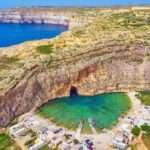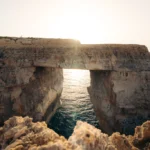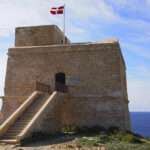Scenic Natural Spots & Outdoor Activities in Malta and Gozo When you think of Malta and Gozo, your mind might instantly wander to historic cities, grand fortresses, and vibrant culture. Yet, these Mediterranean gems also boast breathtaking natural landscapes and endless outdoor activities for those seeking adventure and tranquility. From dramatic cliffs and hidden caves to pristine beaches and rustic countryside trails, the islands are perfect for nature enthusiasts who want to combine relaxation with exploration. Malta’s Natural Treasures & Scenic Natural Spots Dingli Cliffs – Rising dramatically above the sea, the Dingli Cliffs are one of the highest points in Malta, offering panoramic views that stretch to the horizon. This natural wonder is ideal for a serene sunset walk, a peaceful picnic, or simply standing still to admire the raw beauty of the Mediterranean Sea. On clear days, you can even spot the uninhabited island of Filfla in the distance. Walking along the cliffs, you’ll also encounter small chapels and rural landscapes that add to the charm of the area. Blue Grotto – Known for its dazzling sea caves, the Blue Grotto is a must-visit for nature lovers and photography enthusiasts. The best way to experience it is by taking a boat tour in the early morning when the sunlight streams into the caves, illuminating the underwater world with glowing shades of blue, turquoise, and emerald. For the more adventurous, snorkeling and diving around the grotto reveal a rich marine ecosystem teeming with fish and vibrant corals. Golden Bay & Għajn Tuffieħa – These sandy beaches are among Malta’s most famous spots for relaxation and outdoor activities. Golden Bay is family-friendly with plenty of amenities, while Għajn Tuffieħa is quieter, offering a more natural setting. Both are excellent for swimming, paddleboarding, or kayaking. Hikers can take to the surrounding trails, which provide stunning coastal views, especially at sunset when the cliffs and waters are bathed in golden light. Comino and the Blue Lagoon – Between Malta and Gozo lies the tiny island of Comino, home to the famous Blue Lagoon. This sheltered cove boasts crystal-clear waters that are perfect for snorkeling, swimming, or simply floating in paradise. The surrounding cliffs and caves invite exploration by kayak or boat, while inland, Comino offers scenic walking trails for those who wish to discover its wild, unspoiled beauty. Gozo’s Natural Wonders Ramla Bay – Famous for its striking red-golden sand, Ramla Bay is not just a beach but a unique natural landmark. It is the largest sandy beach in Gozo and is framed by green hills, making it a spectacular place for swimming, sunbathing, or snorkeling. A walk up the nearby hills leads to Calypso’s Cave, a spot associated with Homer’s Odyssey, offering views that are as rich in mythology as they are in natural beauty. Ġgantija Temples & Countryside Walks – While the Ġgantija Temples highlight Gozo’s ancient past, the countryside around them is lush with scenic trails. Wander through rustic villages, fertile valleys, and rolling hills while enjoying peaceful walks or cycling routes. Springtime, in particular, paints the countryside CONTINUE READING
Category: Gozo
Gebla tal-Halfa
Gebla tal-Halfa in Gozo. Discover its beauty on a thrilling jet ski safari or a scenic heritage tour by boat and vintage Maltese bus.
Wardija Punic Temple in Gozo
The hidden Wardija Punic Temple in Gozo, a rare ancient sanctuary offering a glimpse into Malta’s Punic past and breathtaking landscapes.
Ras il-Qala
Ras il-Qala in Gozo, a hidden gem with stunning sea views, historic sites, and unspoiled nature perfect for peaceful hikes and sunsets.
Wied il-Mielah in Gozo
Wied il-Mielah Window in Gozo, Malta, a stunning sea arch offering breathtaking views, rugged cliffs, and a peaceful, unspoiled coastal escape.
Dwejra Tower in Gozo
Dwejra Tower in Gozo, Malta, a historic 17th-century watchtower offering stunning coastal views and a glimpse into the island’s rich heritage.
Calypso Cave in Gozo
Calypso’s Cave in Gozo, a legendary site linked to Homer’s Odyssey with views over Ramla Bay, myth, history, and beauty in one place.
Blue Hole in Gozo
Gozo’s iconic Blue Hole — a natural wonder perfect for diving, snorkeling, and sightseeing. Discover it on our “Waves of Heritage” coastal boat trip
Cirkewwa Gozo Channel & Comino Ferry
Cirkewwa Gozo Channel & Comino with Bluewaves Watersports. Ferry trip, stunning lagoons, caves & diving near MV Rozi.
Ta Kola Windmill in Gozo
Ta Kola Windmill in Gozo A Glimpse Into Gozo’s Rural Past Perched in the heart of Xaghra village on the island of Gozo stands a striking structure that instantly transports visitors back to a simpler, slower time. Ta Kola Windmill is one of the few remaining traditional windmills in the Maltese Islands, and it offers a rare and fascinating insight into Gozo’s rural heritage and craftsmanship. Built in the 18th century and lovingly restored, Ta Kola is more than just a historical site—it’s a living museum that celebrates the ingenuity, resilience, and everyday life of Gozitan villagers in the pre-industrial age. Google Location A Historic Landmark with Working Roots Ta Kola Windmill in Gozo was originally constructed in 1725 during the rule of the Knights of St. John, under the direction of Grand Master Manoel de Vilhena. Like many windmills of its time, it was built to serve a vital purpose: grinding wheat and other grains into flour, which was essential for the local community’s sustenance. Its distinctive round stone tower, topped by wooden blades, was designed to harness the power of Gozo’s frequent winds. Unlike decorative windmills you might find elsewhere, Ta Kola was a working building, the heart of a local food system that supported hundreds of families. The name “Ta Kola” comes from Nikola (Kola) Grech, the last miller who worked there. He not only maintained the machinery but also lived onsite, and his legacy lives on through the artifacts, tools, and personal effects preserved inside the mill today. Inside Ta Kola Windmill: A Museum of Maltese Craftsmanship Visiting Ta Kola Windmill feels like stepping into a time capsule. The interior has been restored and curated as a museum that shows what life was like for a traditional miller and craftsman in 19th- and early 20th-century Gozo. The ground floor contains an impressive collection of traditional tools and woodworking equipment, reflecting the dual role many millers had—not only grinding grain but also working as skilled artisans. From chisels to lathes and hammers, each item is a testament to the resourcefulness of a self-sufficient community. Upstairs, the living quarters have been carefully recreated, featuring original furniture, kitchenware, and personal belongings. These rooms offer an intimate look at rural life in Gozo, where families lived modestly but with a deep sense of pride and connection to the land. The windmill tower itself houses the grinding machinery, including the original millstones and wooden gears. While the sails are no longer operational, their structure has been preserved, and visitors can appreciate the intricate design and engineering that once turned wind into flour. A Family-Friendly and Educational Visit Ta Kola Windmill is an ideal stop for families, history lovers, and those curious about Gozitan culture. The museum offers informative panels in multiple languages, and the layout is easy to explore in under an hour, making it a manageable and rewarding addition to any day trip in Xaghra. It’s also a great destination for school groups and educational tours, as it brings to CONTINUE READING












